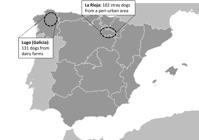Abstract
Dogs play a potential role as reservoirs for zoonotic parasites, being especially problematic uncontrolled dog populations such as stray and farm dogs with access to populated areas. In order to investigate the prevalence of canine intestinal parasites in at-risk dog populations, we tested a total of 233 faecal samples shed by stray and dairy farm dogs from northern Spain. Telemann method was used to detect the presence of eggs and (oo)cysts of common dog intestinal parasites and Cryptosporidium was detected by PCR. One hundred and forty eight out of 233 samples (63.5%) were positive for at least one intestinal parasite, being Ancylostomidae (35.6%; 83/233) and Trichuris (35.2%; 82/233) the parasites most frequently identified. Cryptosporidium DNA was not detected in any of the faecal samples analysed. The overall prevalence was significantly higher in stray dogs than in farm dogs (72.5% vs 58.8%). Specifically, stray dogs had a significantly higher prevalence of Ancylostomatidae, Toxocara, Toxascaris and Taenidae. These dog populations are an important source of environmental contamination with intestinal parasite forms, which could be of significance to animal and human health.
Keywords:
Intestinal parasites; farm dogs; stray dogs; prevalence; coprology

 Thumbnail
Thumbnail
